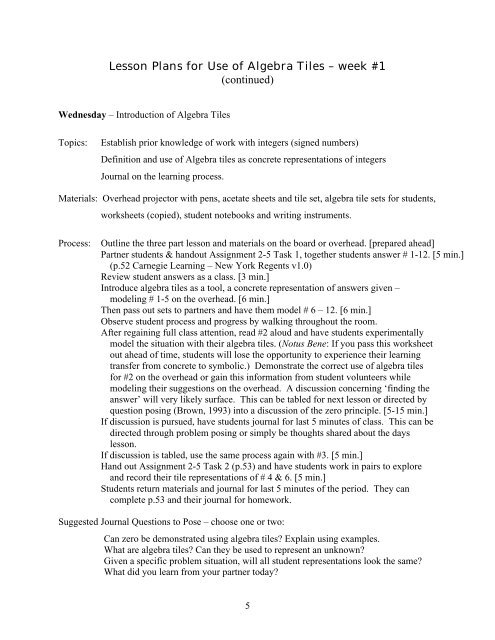Lesson Plans for Use of Algebra Tiles: Instruction
Lesson Plans for Use of Algebra Tiles: Instruction
Lesson Plans for Use of Algebra Tiles: Instruction
You also want an ePaper? Increase the reach of your titles
YUMPU automatically turns print PDFs into web optimized ePapers that Google loves.
<strong>Lesson</strong> <strong>Plans</strong> <strong>for</strong> <strong>Use</strong> <strong>of</strong> <strong>Algebra</strong> <strong>Tiles</strong> – week #1<br />
(continued)<br />
Wednesday – Introduction <strong>of</strong> <strong>Algebra</strong> <strong>Tiles</strong><br />
Topics:<br />
Establish prior knowledge <strong>of</strong> work with integers (signed numbers)<br />
Definition and use <strong>of</strong> <strong>Algebra</strong> tiles as concrete representations <strong>of</strong> integers<br />
Journal on the learning process.<br />
Materials: Overhead projector with pens, acetate sheets and tile set, algebra tile sets <strong>for</strong> students,<br />
worksheets (copied), student notebooks and writing instruments.<br />
Process:<br />
Outline the three part lesson and materials on the board or overhead. [prepared ahead]<br />
Partner students & handout Assignment 2-5 Task 1, together students answer # 1-12. [5 min.]<br />
(p.52 Carnegie Learning – New York Regents v1.0)<br />
Review student answers as a class. [3 min.]<br />
Introduce algebra tiles as a tool, a concrete representation <strong>of</strong> answers given –<br />
modeling # 1-5 on the overhead. [6 min.]<br />
Then pass out sets to partners and have them model # 6 – 12. [6 min.]<br />
Observe student process and progress by walking throughout the room.<br />
After regaining full class attention, read #2 aloud and have students experimentally<br />
model the situation with their algebra tiles. (Notus Bene: If you pass this worksheet<br />
out ahead <strong>of</strong> time, students will lose the opportunity to experience their learning<br />
transfer from concrete to symbolic.) Demonstrate the correct use <strong>of</strong> algebra tiles<br />
<strong>for</strong> #2 on the overhead or gain this in<strong>for</strong>mation from student volunteers while<br />
modeling their suggestions on the overhead. A discussion concerning ‘finding the<br />
answer’ will very likely surface. This can be tabled <strong>for</strong> next lesson or directed by<br />
question posing (Brown, 1993) into a discussion <strong>of</strong> the zero principle. [5-15 min.]<br />
If discussion is pursued, have students journal <strong>for</strong> last 5 minutes <strong>of</strong> class. This can be<br />
directed through problem posing or simply be thoughts shared about the days<br />
lesson.<br />
If discussion is tabled, use the same process again with #3. [5 min.]<br />
Hand out Assignment 2-5 Task 2 (p.53) and have students work in pairs to explore<br />
and record their tile representations <strong>of</strong> # 4 & 6. [5 min.]<br />
Students return materials and journal <strong>for</strong> last 5 minutes <strong>of</strong> the period. They can<br />
complete p.53 and their journal <strong>for</strong> homework.<br />
Suggested Journal Questions to Pose – choose one or two:<br />
Can zero be demonstrated using algebra tiles? Explain using examples.<br />
What are algebra tiles? Can they be used to represent an unknown?<br />
Given a specific problem situation, will all student representations look the same?<br />
What did you learn from your partner today?<br />
5

















